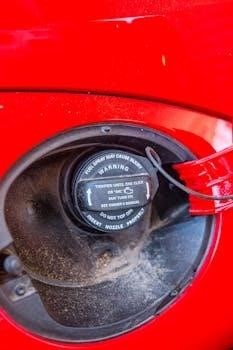Lewis Pumps⁚ An Overview
Lewis Pumps, established in 1940, specializes in vertical submerged molten sulphur pumps, offering a family of steam-jacketed options․ They combine expertise in pump hydraulics, metallurgy, and mechanical engineering․ Their pumps are designed for diverse sulphur applications and high-temperature sulphuric acid environments․
Historical Background of Lewis Pumps
Lewis Pumps embarked on its journey in 1940, initially focusing on the production of vertical submerged molten sulphur pumps․ This marked the beginning of their expertise in pump hydraulics, metallurgy, and mechanical engineering․ Over the years, Lewis Pumps has become a recognized name, particularly in North America, where their molten sulphur pumps are considered a standard in the industry․ The company’s development reflects a commitment to meeting diverse sulphur application needs through innovative designs and robust construction․ Their experience in demanding environments has driven their evolution, leading to the development of specialized pumps and materials like Lewmet alloys, tailored for specific corrosive and high-temperature applications․ This historical journey underscores their dedication to providing reliable and efficient solutions for challenging industrial processes, establishing a strong legacy in fluid handling․
Types of Lewis Pumps
Lewis Pumps offers a diverse range of pumps designed for specific industrial applications․ Among their offerings are vertical submerged molten sulphur pumps, engineered for the efficient transfer of molten sulphur in refineries, gas, and acid plants․ These pumps come in distinct configurations and are often steam-jacketed for temperature control․ Furthermore, Lewis manufactures vertical sulphuric acid pumps, designed to withstand high temperatures and corrosive environments associated with sulphuric acid and oleum applications․ The company also produces axial flow pumps, suitable for chemical processing, particularly in evaporators and crystallizers, where corrosive and high-temperature conditions are common․ These axial flow pumps are designed with flexible construction and utilize Lewmet alloys for enhanced erosion and corrosion resistance․ The wide selection of pumps reflects Lewis’s commitment to providing solutions for diverse and challenging fluid handling needs․
Vertical Submerged Molten Sulphur Pumps
Lewis Pumps’ vertical submerged molten sulphur pumps are specifically engineered for the unique demands of sulphur production and processing․ These pumps are designed to handle molten sulphur, a highly corrosive and temperature-sensitive fluid, with utmost efficiency and reliability․ The pumps are typically supplied in various configurations to suit diverse plant layouts and operational requirements․ They often incorporate steam-jacketing to maintain the molten sulphur at the required temperature, preventing solidification and ensuring smooth operation․ Lewis vertical submerged pumps are considered an industry standard, particularly in North America, for their proven performance and durability in the challenging environments of sulphur handling․ They are designed for the transfer and processing of sulphur in refineries, gas plants, and acid production facilities․ The pumps are built to combine hydraulics, metallurgy, and mechanical engineering for optimal performance․

Vertical Sulphuric Acid Pumps
Lewis vertical sulphuric acid pumps are engineered for exceptional performance and reliability in high-temperature sulphuric acid and oleum applications․ These pumps are specifically designed to withstand the corrosive nature of these fluids, ensuring long-lasting operation in demanding chemical processing environments․ They are built with heavy-duty construction to provide smooth, vibration-free operation while handling the challenging properties of sulphuric acid․ Lewis pumps are designed for simplicity, making them easy to maintain and service․ The use of specialized materials, like Lewmet alloys, further enhances their resistance to corrosion and erosion, ensuring their suitability for harsh operating conditions․ These pumps are crucial for maintaining the integrity of sulphuric acid and oleum handling in various industrial processes․ Lewis pumps provide operators with the assurance of reliable performance in critical chemical applications․

Axial Flow Pumps
Lewis axial flow pumps are specifically designed for use in corrosive and high-temperature chemical processing applications, including evaporator and crystallizer circulation․ The all-new Lewis VL axial flow pump boasts a flexible design and heavy-duty construction․ A key feature is the wide range of material options, including Lewmet alloys, which provide exceptional resistance to erosion and corrosion in extreme conditions․ These pumps are engineered for reliable performance in demanding industrial settings where other pumps may fail․ Modifications to the size and characteristics of these pumps are significant, as industrial flow fields differ from those in medical applications․ The pumps are designed for simplicity and built with the durability needed for continuous operation in harsh conditions․ Their robust design ensures a long service life․
Materials Used in Lewis Pumps
Lewis Pumps utilizes a range of specialized materials to ensure durability and reliability in harsh operating conditions; These materials include Lewmet alloys, which are nickel-chrome alloys engineered to withstand long-term exposure in corrosive environments, particularly those found in contact process sulphuric acid production․ Additionally, Lewis Pumps incorporates nitrile and EPDM rubber compounds in their designs․ These compounds, such as MC97, are used in impellers to resist the breakdown caused by exposure to oils and other chemicals․ The choice of materials is crucial for ensuring the pumps can operate efficiently and reliably in demanding industrial applications․ The materials are selected to provide optimal resistance to wear, corrosion, and chemical degradation․ This commitment to high-quality materials makes Lewis pumps suitable for extreme conditions․
Lewmet Alloys
Lewmet alloys are a critical component in the construction of Lewis Pumps, specifically engineered to withstand the severe conditions encountered in various industrial applications․ These alloys are primarily nickel-chrome based, formulated for exceptional resistance to corrosion and erosion․ The development of Lewmet alloys stems from decades of metallurgical experience in manufacturing pumping equipment․ They are particularly suited for environments involving contact process sulphuric acid, where other materials may degrade rapidly․ The unique composition of Lewmet alloys ensures long-term performance and reliability, minimizing the need for frequent replacements․ This focus on material science underscores Lewis Pumps’ commitment to providing robust and durable solutions for challenging pumping needs․ The alloys’ performance is a key factor in the overall lifespan of Lewis pumps․
Nitrile and EPDM Rubber Compounds
Nitrile and EPDM rubber compounds are essential materials used in Lewis pumps, particularly for components like impellers and seals․ These materials are chosen for their specific properties that enhance pump performance and durability․ Nitrile rubber offers excellent resistance to oils and fuels, making it ideal for applications where exposure to these substances is likely․ EPDM, or ethylene propylene diene monomer, rubber is selected for its superior resistance to a wide range of chemicals, heat, and weathering․ This compound is often used in applications where pumps are exposed to harsh conditions․ The use of these specific rubber compounds is part of Lewis Pumps’ strategy to ensure the long-term reliability and efficiency of their products, minimizing downtime and maintenance needs while maximizing operational lifespan․ They are particularly important in sea water pumps exposed to various chemicals․
Applications of Lewis Pumps
Lewis pumps find extensive use across various industrial sectors due to their robust design and material construction․ These pumps are particularly crucial in the sulphur production and processing industries, where their vertical submerged molten sulphur pumps are considered a standard․ Their applications extend to sulphuric acid and oleum handling, where their pumps are engineered to withstand high temperatures and corrosive environments․ Furthermore, Lewis pumps are integral to chemical processing plants, providing reliable fluid transfer and circulation for various corrosive and high-temperature materials․ The axial flow pumps are ideal for use in evaporators and crystallizers; These pumps are designed for simplicity and built with high-quality materials, which ensures smooth, vibration-free operation, contributing to their widespread adoption in demanding applications․ Their versatility makes them indispensable in diverse operations․
Sulphur Production and Processing
Lewis pumps play a pivotal role in sulphur production and processing, particularly in refineries, gas, and acid plants․ Their vertical submerged molten sulphur pumps are specifically designed for the demanding conditions of handling molten sulphur․ These pumps are available in two configurations to meet diverse operational needs within the industry․ The reliability and efficiency of Lewis pumps are crucial in the transfer and processing of sulphur, where consistent and safe operation is paramount․ Due to their robust construction and material selection, they handle the high temperatures and corrosive nature of molten sulphur effectively․ This makes them an industry standard in North America and other regions, ensuring smooth and dependable sulphur handling throughout the production process․ The pumps are essential for the overall efficiency and safety of sulphur-related operations․
Sulphuric Acid and Oleum Applications
Lewis pumps are specifically engineered for the challenging demands of sulphuric acid and oleum applications, ensuring outstanding performance and reliability in these high-temperature and corrosive environments․ These pumps are designed to handle the extreme conditions associated with sulphuric acid and oleum processing․ The materials used in their construction, including Lewmet alloys, are chosen to withstand the corrosive effects and high temperatures involved in these applications, maintaining their structural integrity and operational efficiency․ This makes Lewis pumps a dependable choice for plant operators, ensuring the smooth and safe transfer of these highly corrosive chemicals; The pumps’ design emphasizes durability and long-term performance, providing a reliable solution for the demanding requirements of sulphuric acid and oleum handling within various industrial processes․ Their performance is crucial in maintaining the safety and efficiency of chemical processing plants․

Chemical Processing

Lewis pumps, particularly the axial flow models, are well-suited for a broad spectrum of chemical processing applications, especially those involving corrosive and high-temperature environments․ These pumps excel in handling the demanding conditions found in evaporators and crystallizers, where reliable circulation is vital for efficient operation․ The use of Lewmet alloys in their construction ensures resistance to erosion and corrosion, which are common challenges in chemical processing․ Their robust design makes them suitable for continuous duty in harsh chemical environments, contributing to the safety and reliability of the overall production process․ The pumps are engineered to maintain consistent performance, which is critical in chemical processes where precise flow rates and pressures are required․ This adaptability allows for use in diverse chemical plants, ensuring effective and long-lasting service․
Servicing and Maintenance of Lewis Pumps
Maintaining Lewis pumps, especially vertical sulphur pumps, involves a comprehensive approach to ensure their longevity and optimal performance․ Servicing includes regular inspections, careful disassembly, and precise assembly procedures․ Clearances must be accurately set during reassembly; Proper lubrication is crucial for smooth operation․ Troubleshooting these pumps requires a systematic approach, addressing common issues such as vibration or reduced flow․ Manuals provide detailed guidance on these processes, including ATEX information for safe handling in hazardous environments․ Maintenance protocols are essential to avoid damage and ensure the pump’s continued effectiveness․ Proper upkeep involves checking for wear and tear, replacing worn components, and ensuring all parts are functioning correctly․ Regular servicing extends the operational life of the pump and prevents costly breakdowns;
Troubleshooting Vertical Sulphur Pumps
Troubleshooting Lewis vertical sulphur pumps requires a systematic approach, addressing common issues that can arise during operation․ One frequent problem is reduced flow or pressure, which can often be traced back to impeller wear, blockages within the pump, or issues with the suction or discharge lines․ Vibrations are another common concern, often stemming from misalignment, loose components, or bearing problems․ Unusual noises during operation should be immediately investigated, as they could indicate serious issues․ Examining the pump’s lubrication system is also critical; insufficient lubrication can lead to overheating and premature wear․ The pump’s installation should also be checked, as incorrect mounting can contribute to operational problems․ A careful inspection of the pump’s components is necessary to pinpoint the source of the issue and to implement the correct remedy, following the provided manuals․
Inspection and Disassembly Procedures
Prior to any disassembly, a thorough inspection of the Lewis pump is crucial․ Begin by visually checking for any external damage, leaks, or unusual wear․ Note any signs of corrosion or erosion, especially in areas exposed to harsh chemicals․ Document the pump’s operational history and any issues noted by operators․ Next, ensure the pump is completely isolated from the power source and any process fluids․ Follow the specific step-by-step disassembly procedures outlined in the Lewis pump manual․ Take pictures of each stage of disassembly to assist with reassembly․ Pay close attention to the order and orientation of each component as it is removed․ Clean and label all parts before further inspection․ Look for signs of wear, cracks, or other damage on critical components such as the impeller, bearings, seals, and shafts․
Assembly and Clearances
Proper assembly of Lewis pumps is critical for reliable operation․ Begin by ensuring all components are clean and free from any debris․ Refer to the Lewis pump manual for the correct order of assembly․ Lubricate all necessary parts with the recommended lubricant before reassembling․ Carefully align components to prevent damage during assembly․ Pay special attention to the proper installation of seals and gaskets to ensure leak-free operation․ Correct clearances between moving parts are crucial for smooth operation and to prevent premature wear․ Use precision measuring tools to verify clearances as specified in the manual․ Ensure all fasteners are tightened to the correct torque specifications․ Rotating parts should turn freely without binding․ Once assembled, perform a final inspection before putting the pump back into service․ Verify the pump is properly aligned with the motor, and ensure all safety devices are in place․
Operational Instructions for Lewis Pumps
Prior to starting a Lewis pump, it is essential to conduct a thorough inspection, ensuring all connections are secure and the pump is properly aligned․ Verify the correct fluid type and temperature, and check that the pump is primed if required․ Adhere to the specified operating speed, typically 540 RPM for optimal performance, and avoid running the pump dry․ During operation, monitor pressure and flow rates to identify potential issues․ Regularly inspect for leaks or unusual noises, which could indicate a problem․ If any abnormalities arise, promptly shut down the pump and refer to the troubleshooting section of the manual․ Always maintain proper lubrication as specified in the maintenance schedule to ensure smooth and efficient performance․ When shutting down, follow the correct procedure to prevent damage to pump components․ It’s crucial to keep the area around the pump clear for safety and accessibility․ Always consult the Lewis pump manual for specific operational instructions and safety guidelines․



